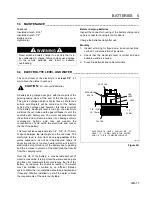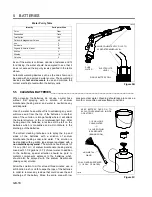
4 OPERATION
GB-14
4.5 TO DRIVE / TRANSPORT ____________________________________________________
If the tractor is driven on public roads, it must comply with
federal, state and local ordinances. Contact local
authorities for regulations and equipment requirements.
1.
Disengage all drives and raise implements to the
transport position when driving to and from the area
of operation.
2.
Disengage parking brake, set travel switch to “Fast”.
Depress traction pedal slowly.
.
4.6
OPERATING RANGE _______________________________________________________
The operating range of the tractor will vary depending on
terrain, outside temperature, the size and condition of the
batteries, wiring connections and lubrication.
Terrain - Traveling over hills and slopes will use more
power than traveling over flat ground. If possible, select
level routes rather than traveling over hills.
Outside temperature - Low temperatures reduce the
power output of batteries. To increase range in cold
weather use batteries with a higher amp rating.
Battery Size - Batteries with higher amp ratings will
increase the effective range of the tractor.
Battery Condition - As a battery ages its capacity will
diminish, slightly reducing the maximum range of the
tractor. Keeping the electrolyte at the correct level and
keeping batteries clean and free of corrosion can help
keep batteries at peak capacity longer.
Connections - Loose battery connections and wiring can
increase resistance in the circuits that will affect
performance and range.
Lubrication - Regular lubrication will reduce resistance
to moving parts and consume less power than a poorly
lubricated machine.
4.7
RAKE ATTACHMENT _______________________________________________________
To attach rake:
1.
Start tractor and lower rake bail (A). Turn off tractor,
remove key and disconnect battery connector.
2.
Attach hitch (G) to tractor in center holes using
clevis pin (B)as shown. Secure in place with locking
pin (C).
3.
Attach bar assembly to hitch using clevis pin and
locking pin (D).
4.
Attach rake lift chains to hooks on tractor (E). Check
that all hardware holding chains is tight (F).
5.
Start tractor and raise and lower rake several times
to check operation.
To remove rake: Lower rake bail, turn off tractor, remove
key and disconnect batteries. Unhook lift chains and
remove clevis pin from hitch. Store clevis pin and locking
pin in rake bar when not in use.
Do not lubricate or grease rake or hitch. Grease and oil
will retain abrasive particles, such as sand, and increase
wear.
Figure 4A
CAUTION:
To prevent tipping or loss of
control, travel at reduced speeds when mak-
ing turns or traveling on hills.
!
A
B
C
D
E
F
TR005
G















































